New Development Direction of Underground Logistics from the Perspective of Public Transport: A Systematic Review Based on Scientometrics
Abstract
:1. Introduction
- Can we find out the current international research status, hot spots, and research trends of ULS, public transport, and M-ULS?
- Can we organize the papers in a taxonomy and highlight the research mainstreams and future directions?
- Can we see any lack in current frameworks in the literature, in terms of current trends and future paths?
2. Materials and Methods
2.1. Overview of Review Protocol
2.2. Literature Retrieval and Selection
2.3. Overview of Selected Literature
3. Scientometrics Experiments and Analysis
3.1. Countries/Organizations Collaboration Experiments
3.2. Authorship Collaboration Experiments
3.2.1. Co-Author Network
3.2.2. Author Co-Citation Network
3.3. Keywords Co-Occurrence Experiments
Co-Occurrence Keywords
3.4. Literature Evolution Path
4. Discussion
4.1. Taxonomy Construction
- We began with the empirical analysis of a database of papers. The titles and abstracts were checked one by one, and those unrelated to the research topic were removed, as shown in Table 1.
- In the second stage, the information obtained in the first stage was clustered. CiteSpace was used to cluster closely related keywords through log likelihood ratio (LLR) algorithm, obtaining 17 noticeable clusters, as shown in Table 7.
- In the third stage, a mental concept of the cluster was envisioned by generating a name or label for the cluster, which was integrated into one of three research topics. Figure 11 depicts the result of our process and is structured in three levels of detail.
4.2. Part 1 Urban Underground Logistics System and Planing
4.2.1. Research on ULS Concept
4.2.2. Sustainable Underground Transportation System
4.2.3. Urban Underground Logistics Planning
4.3. PART 2 Design and Implementation of Transportation Organization
4.3.1. Organizational Form and Dynamic System
4.3.2. Typical Transport Systems and Vehicle
4.3.3. Rail Transit Coordinated Transport
- (1)
- Shared track: freight is transported by a separate vehicle that only shares with public transport infrastructure.
- (2)
- Shared vehicles: freight is transported in separate trucks or additional trailers.
- (3)
- Shared truck: freight and passenger are transported in the same truck or carriage.
| References | Type of Study | Track Type | Sharing | Background | STU | Last Mile | Freight Type | Analysis Content | Service Range |
|---|---|---|---|---|---|---|---|---|---|
| [70] | Case Study Simulation | Metro | Track Vehicle | Madrid, Spain | Container | Locker | B2C | Operating costs Externality benefits | Network |
| [68] | Case Study Simulation | Metro | Track Vehicle Wagon | Chengdu, China | Container Trolley | - | Parcel | Capacity CO2 emissions | Single line |
| [66] | Desk Study | Urban rail transit | Vehicle | — | — | Bike Motorbike | B2B B2C | — | Network |
| [25] | Case Study | Metro | Wagon | Sapporo, Japan | Trolley | Vehicle | B2BB2C | Public satisfaction | Single line |
| [72] | Case Study | Trams and trains | — | Belgium | — | — | — | Externality benefits | Network |
| [73] | Case Study Simulation | Urban rail transit | Vehicle | Beijing, China | Standardized transport units | E-Vehicles Cargo-bikes Lockers | Parcel | Externality benefits | Network |
| [35] | Case Study Simulation | Metro | Track Vehicle | Beijing, China | Containers Pallets | E-Vehicles, cargo-bikes, Drones, Crowdsourcing | Parcel | Innovative concepts for M-ULS prototypes | Network |
| [76] | Case Study | Metro | Vehicle Wagon | Newcastle upon Tyne, UK | Wheeled boxes | Cargo bikes, Electric | — | Designs for the interior of the metro carriage | Single Line |
| [24] | Case Study Simulation | Urban rail transit | Track Vehicle | Newcastle upon Tyne, UK | Logistic boxes | Manual pick-up | B2B B2C | Scheduling | Network |
| [75] | Case Study Simulation | Metro | Track Vehicle | Newcastle upon Tyne, UK | Containers Cradles | Manual pick-up | Baggage | Capacity Scheduling | Single Line |
| [71] | Case Study | Metro | — | Rome, Italy | — | Locker | B2C | Underlying behavior | Network |
| [74] | Case Study | Tram | Track | Barcelona, Spain | — | Cross-docking facilities Perpendicular short side tracks | B2C Waste | Cost benefit analysis | Network |
| [80] | Review | Tram | Track | Dresden, Germany | Containers | — | Car parts | — | Single Line |
| [79] | Review | Tram | Track | Zurich, Switzerland | — | Manual pick-up | Waste | — | Network |
4.4. PART 3 Network Structure and Operation Optimization
4.4.1. Network Structure Analysis
4.4.2. Facility Location Problem (FLP)
4.4.3. Routing Problem (RP)
4.4.4. Terminal Connection Problem (TCP)
4.4.5. Competitive Allocation Problem(CAP)
5. M-ULS Research Gaps and Agenda
5.1. Theoretical Research
5.1.1. Large-Scale Simulation System
5.1.2. Cost–Benefit Quantitative Research
5.1.3. Market Competition and Game
5.1.4. Multimodal Transport Network Coupling
5.1.5. M-ULS Operation Scheme
5.2. Application Implementation
5.2.1. Policy-Making
5.2.2. Planning of Underground Space
5.2.3. Design of Integrated Dispatching System
5.2.4. Facility Transformation
5.2.5. Operational Safety
6. Conclusions
Author Contributions
Funding
Institutional Review Board Statement
Informed Consent Statement
Data Availability Statement
Conflicts of Interest
References
- Cui, J.; Dodson, J.; Hall, P.V. Planning for Urban Freight Transport: An Overview. Transp. Rev. 2015, 35, 583–598. [Google Scholar] [CrossRef]
- Qian, Q.; Guo, D.; Chen, Z. Discussion on alleviating traffic congestion in Beijing—Urban underground logistics system. In Proceedings of the 11th Annual Meeting of China Society of Civil Engineering and the 13th Annual Meeting of Tunnel and Underground Engineering Branch, Beijing, China, 27–29 November 2004; pp. 747–754. [Google Scholar]
- Visser, J.G.S.N. The development of underground freight transport: An overview. Tunn. Undergr. Space Technol. 2018, 80, 123–127. [Google Scholar] [CrossRef]
- Savelsbergh, M.; Van Woensel, T. 50th Anniversary Invited Article-City Logistics: Challenges and Opportunities. Transp. Sci. 2016, 50, 579–590. [Google Scholar] [CrossRef]
- Chen, Y.; Dong, J.; Shang, P.; Chen, Z.; Ren, R. Research on the Cooperative Transportation Modes between Metro and Underground Logistics System in Urban Area. Chin. J. Undergr. Space Eng. 2020, 16, 637–646. [Google Scholar]
- Mingers, J.; Leydesdorff, L. A review of theory and practice in scientometrics. Eur. J. Oper. Res. 2015, 246, 1–19. [Google Scholar] [CrossRef] [Green Version]
- Chen, C.M. Searching for intellectual turning points: Progressive knowledge domain visualization. Proc. Natl. Acad. Sci. USA 2004, 101, 5303–5310. [Google Scholar] [CrossRef] [Green Version]
- Chen, C.; Song, M. Visualizing a field of research: A methodology of systematic scientometric reviews. PLoS ONE 2019, 14, e0223994. [Google Scholar] [CrossRef] [Green Version]
- Wang, L.; Xue, X.; Zhao, Z.; Wang, Z. The Impacts of Transportation Infrastructure on Sustainable Development: Emerging Trends and Challenges. Int. J. Environ. Res. Public Health 2018, 15, 1172. [Google Scholar] [CrossRef] [Green Version]
- Martinez, S.; Delgado, M.D.M.; Marin, R.M.; Alvarez, S. Science mapping on the Environmental Footprint: A scientometric analysis-based review. Ecol. Indic. 2019, 106, 105543. [Google Scholar] [CrossRef]
- Hu, W.; Dong, J.; Hwang, B.-G.; Ren, R.; Chen, Z. A Scientometrics Review on City Logistics Literature: Research Trends, Advanced Theory and Practice. Sustainability 2019, 11, 2724. [Google Scholar] [CrossRef] [Green Version]
- Chen, J.; Su, Y.; Si, H.; Chen, J. Managerial Areas of Construction and Demolition Waste: A Scientometric Review. Int. J. Environ. Res. Public Health 2018, 15, 2350. [Google Scholar] [CrossRef] [PubMed] [Green Version]
- Zhao, X. A scientometric review of global BIM research: Analysis and visualization. Autom. Constr. 2017, 80, 37–47. [Google Scholar] [CrossRef]
- Olawumi, T.O.; Chan, D.W.M. A scientometric review of global research on sustainability and sustainable development. J. Clean. Prod. 2018, 183, 231–250. [Google Scholar] [CrossRef]
- Chen, C.M. CiteSpace II: Detecting and visualizing emerging trends and transient patterns in scientific literature. J. Am. Soc. Inf. Sci. Technol. 2006, 57, 359–377. [Google Scholar] [CrossRef] [Green Version]
- Vernimmen, B.; Dullaert, W.; Geens, E.; Notteboom, T.; T’Jollyn, B.; Van Gilsen, W.; Winkelmans, W. Underground logistics systems: A way to cope with growing internal container traffic in the port of Antwerp? Transp. Plan. Technol. 2007, 30, 391–416. [Google Scholar] [CrossRef]
- Pielage, B.J. Underground freight transportation. A new development for automated freight transportation systems in the Netherlands. In Proceedings of the 2001 IEEE Intelligent Transportation Systems Proceedings, Oakland, CA, USA, 25–29 August 2001; pp. 762–767. [Google Scholar]
- Stein, D.; Schoesser, B.; Najafi, M. CargoCap-Transportation of Goods through Underground Pipelines: Research Project in Germany. In Proceedings of the ASCE International Conference on Pipeline Engineering and Construction: New Pipeline Technologies, Security and Safety, Baltimore, MD, USA, 13–16 July 2003; American Society of Civil Engineers Texas Section: Baltimore, MD, USA, 2003; pp. 1625–1634. [Google Scholar]
- Liu, H.; Galleher, J.J.; Stift, M.T. Feasibility of Underground Pneumatic Freight Transport in New York City. In Proceedings of the ASCE Pipeline Division Specialty Congress—Pipeline Engineering and Construction—What’s on the Horizon, San Diego, CA, USA, 1–4 August 2004; pp. 1085–1096. [Google Scholar]
- Qingfen, Z.; Yu, S.; Shan, L. The Prospect of Underground Logistics System of Shanghai in E-Commerce Era. Chin. J. Undergr. Space Eng. 2011, 7, 1269–1273. [Google Scholar]
- Wiegmans, B.W.; Visser, J.; Konings, R.; Pielage, B.J.A. Review of underground logistic systems in the Netherlands: An ex-post evaluation of barriers, enablers and spin-offs. Eur. Transp. Trasp. Eur. 2010, 45, 34–49. [Google Scholar]
- Egbunike, O.N.; Potter, A.T. Are freight pipelines a pipe dream? A critical review of the UK and European perspective. J. Transp. Geogr. 2011, 19, 499–508. [Google Scholar] [CrossRef]
- Fatnassi, E.; Chaouachi, J.; Klibi, W. Planning and operating a shared goods and passengers on-demand rapid transit system for sustainable city-logistics. Transp. Res. Part B-Methodol. 2015, 81, 440–460. [Google Scholar] [CrossRef]
- Motraghi, A.; Marinov, M.V. Analysis of urban freight by rail using event based simulation. Simul. Model. Pract. Theory 2012, 25, 73–89. [Google Scholar] [CrossRef]
- Kikuta, J.; Ito, T.; Tomiyama, I.; Yamamoto, S.; Yamada, T. New subway-integrated city logistics system. In Seventh International Conference on City Logistics; Taniguchi, E., Thompson, R.G., Eds.; Elsevier: Amsterdam, The Netherlands, 2012; Volume 39, pp. 476–489. [Google Scholar]
- Qihu, Q. Present state, problems and development trends of urban underground space in China. Tunn. Undergr. Space Technol. 2016, 55, 280–289. [Google Scholar] [CrossRef]
- Bobylev, N.; Sterling, R. Urban underground space A growing imperative Perspectives and current research in planning and design for underground space use. Tunn. Undergr. Space Technol. 2016, 55, 1–4. [Google Scholar] [CrossRef]
- Zhong, Y.; Luo, S.; Bao, M.; Lv, X. Dynamic Network Planning of Underground Logistics System on Uncertainty Graph. Math. Probl. Eng. 2019, 2019, 1979275. [Google Scholar] [CrossRef]
- Wei, H.; Li, A.; Jia, N. Research on Optimization and Design of Sustainable Urban Underground Logistics Network Framework. Sustainability 2020, 12, 9147. [Google Scholar] [CrossRef]
- Dong, J.; Xu, Y.; Hwang, B.-G.; Ren, R.; Chen, Z. The Impact of Underground Logistics System on Urban Sustainable Development: A System Dynamics Approach. Sustainability 2019, 11, 1223. [Google Scholar] [CrossRef] [Green Version]
- Zahed, S.E.; Shahooei, S.; Farooghi, F.; Shahandashti, M.; Ardekani, S. Life-cycle cost analysis of a short-haul underground freight transportation system for the DFW Airport. Built Environ. Proj. Asset Manag. 2019, 9, 440–456. [Google Scholar] [CrossRef]
- Xinwei, P.; Dong, J.; Fu, G.; Zhang, G. Study on Comprehensive Evaluation Method of Underground Logistics System Feasibility Based on ANP-TOPSIS Method. Chin. J. Undergr. Space Eng. 2019, 15, 684–690. [Google Scholar]
- Ghilas, V.; Demir, E.; Van Woensel, T. An adaptive large neighborhood search heuristic for the Pickup and Delivery Problem with Time Windows and Scheduled Lines. Comput. Oper. Res. 2016, 72, 12–30. [Google Scholar] [CrossRef] [Green Version]
- Behiri, W.; Belmokhtar-Berraf, S.; Chu, C. Urban freight transport using passenger rail network: Scientific issues and quantitative analysis. Transp. Res. Part E Logist. Transp. Rev. 2018, 115, 227–245. [Google Scholar] [CrossRef]
- Hu, W.; Dong, J.; Hwang, B.-G.; Ren, R.; Chen, Z. A preliminary prototyping approach for emerging metro-based underground logistics systems: Operation mechanism and facility layout. Int. J. Prod. Res. 2020, 59, 7516–7536. [Google Scholar] [CrossRef]
- Zhao, L.; Li, H.; Li, M.; Sun, Y.; Hu, Q.; Mao, S.; Li, J.; Xue, J. Location selection of intra-city distribution hubs in the metro-integrated logistics system. Tunn. Undergr. Space Technol. 2018, 80, 246–256. [Google Scholar] [CrossRef]
- Dong, J.; Hu, W.; Yan, S.; Ren, R.; Zhao, X. Network Planning Method for Capacitated Metro-Based Underground Logistics System. Adv. Civ. Eng. 2018, 2018, 6958086. [Google Scholar] [CrossRef] [Green Version]
- Zheng, C.; Gu, Y.; Shen, J.; Du, M. Urban logistics delivery route planning based on a single metro line. IEEE Access 2021, 9, 50819–50830. [Google Scholar] [CrossRef]
- Zhou, X.-Y.; Cui, Y.; He, L.; Ma, X.-Y.; Wang, S.-C. Logistics Distribution Routing Optimization Based on Subway-freight Truck Intermodal Transportation. . Transp. Syst. Eng. Inf. Technol. 2020, 20, 111–117. [Google Scholar]
- Chebbi, O.; Chaouachi, J. Reducing the wasted transportation capacity of Personal Rapid Transit systems: An integrated model and multi-objective optimization approach. Transp. Res. Part E Logist. Transp. Rev. 2016, 89, 236–258. [Google Scholar] [CrossRef]
- Cleophas, C.; Cottrill, C.; Ehmke, J.F.; Tierney, K. Collaborative urban transportation: Recent advances in theory and practice. Eur. J. Oper. Res. 2019, 273, 801–816. [Google Scholar] [CrossRef]
- Wang, J.; Ren, J.; Fu, X. Research on Bus and Metro Transfer from Perspective of Hypernetwork—A Case Study of Xi’an, China (December 2020). IEEE Access 2020, 8, 227048–227063. [Google Scholar] [CrossRef]
- Li, B.X.; Krushinsky, D.; Reijers, H.A.; Van Woensel, T. The Share-a-Ride Problem: People and parcels sharing taxis. Eur. J. Oper. Res. 2014, 238, 31–40. [Google Scholar] [CrossRef] [Green Version]
- Guo, D.; Chen, Y.; Yang, J.; Tan, Y.H.; Zhang, C.; Chen, Z. Planning and application of underground logistics systems in new cities and districts in China. Tunn. Undergr. Space Technol. 2021, 113, 103947. [Google Scholar] [CrossRef]
- Fan, Y.; Liang, C.; Hu, X.; Li, Y. Planning connections between underground logistics system and container ports. Comput. Ind. Eng. 2020, 139, 106199. [Google Scholar] [CrossRef]
- Hai, D.; Xu, J.; Duan, Z.; Chen, C. Effects of underground logistics system on urban freight traffic: A case study in Shanghai, China. J. Clean. Prod. 2020, 260, 121019. [Google Scholar] [CrossRef]
- Ferrero, F.; Perboli, G.; Rosano, M.; Vesco, A. Car-sharing services: An annotated review. Sustain. Cities Soc. 2017, 37, 501–518. [Google Scholar] [CrossRef]
- Shahooei, S.; Farooghi, F.; Zahedzahedani, S.E.; Shahandashti, M.; Ardekani, S. Application of underground short-haul freight pipelines to large airports. J. Air Transp. Manag. 2018, 71, 64–72. [Google Scholar] [CrossRef]
- Rezaie, N.; Tabesh, A.; Najafi, M.; Ma, B.; Mousavipour, S.H.; Livingston, B.L.; Geisbush, J.; Cate, C.; Heidrick, J.W.; Pridmore, A. Evaluation of Applications and the Comparison of Routes for Underground Freight Transportation in Texas. In Proceedings of the Pipelines 2016 Conference: Out of Sight, Out of Mind, Not Out of Risk, Kansas, MO, USA, 17–20 July 2016; American Society of Civil Engineers (ASCE): Reston, VA, USA, 2016; pp. 847–856. [Google Scholar]
- Qian, Q. The fundamental solutions to urban traffic congestion, air pollution and rain, flood and waterlogging. Sci. Technol. Rev. 2015, 33, 1–2. [Google Scholar]
- Liu, Y. Analysis on Motivation of Underground Fast-driving Road Construction. Chin. J. Undergr. Space Eng. 2006, S2, 1293–1296. [Google Scholar]
- Shang, P.C.; Chen, Y.C.; Luo, G.L.; Guo, D.J.; Su, X.C. Using Underground Logistics System to Mitigate the Congestion of Urban Transportation Network; Clausius Scientific Press: Ottawa, ON, Canada, 2019; pp. 69–76. [Google Scholar]
- Lu, B.; Zhang, M.X.; Lu, B. Study on Underground Logistics System Planning in the Jinan Prior Zone. In Proceedings of the China Rock 2020 Conference, Beijing, China, 23–26 October 2020; IOP Conference Series: Earth and Environmental Science. Volume 570, p. 062028. [Google Scholar] [CrossRef]
- Zahed, S.E.; Shahandashti, S.M.; Najafi, M. Lifecycle benefit-cost analysis of underground freight transportation systems. J. Pipeline Syst. Eng. Pract. 2018, 9, 04018003. [Google Scholar] [CrossRef]
- Tabesh, A.; Najafi, M.; Ashoori, T.; Tavakoli, R.; Shahandashti, S.M.; Pridmore, A.; Geisbush, J. Environmental Impacts of Pipeline Construction for Underground Freight Transportation. In Proceedings of the Pipelines 2017 Conference: Planning and Design, Phoenix, AZ, USA, 6–9 August 2017; American Society of Civil Engineers (ASCE): Reston, VA, USA, 2017; pp. 181–191. [Google Scholar]
- O’Connell, R.M.; Lenau, C.W.; Zhao, T. Capsule Separation by Linear Induction Motor in Pneumatic Capsule Pipeline Freight Transport System. J. Pipeline Syst. Eng. Pract. 2010, 1, 84–90. [Google Scholar] [CrossRef]
- Asim, T.; Mishra, R. Computational fluid dynamics based optimal design of hydraulic capsule pipelines transporting cylindrical capsules. Powder Technol. 2016, 295, 180–201. [Google Scholar] [CrossRef] [Green Version]
- Shahooei, S.; Mattingly, S.P.; Shahandashti, M.; Ardekani, S. Propulsion system design and energy optimization for autonomous underground freight transportation systems. Tunn. Undergr. Space Technol. 2019, 89, 125–132. [Google Scholar] [CrossRef]
- Tsunashima, H.; Kaneko, T. Performance analysis of lateral guidance system for dual mode truck. J. Vehicle SystemDynamics. 1998, 29 (Suppl. S1), 754–759. [Google Scholar] [CrossRef]
- Levien, M. Freight Shuttle System: Cross-Border Movement of Goods. 2011. Available online: https://click.endnote.com/viewer?doi=10.2172%2F1048877&token=WzI3MjM4MTksIjEwLjIxNzIvMTA0ODg3NyJd.n0tQOX9XXK68-0y0ezWAuJnsYAo (accessed on 1 January 2022).
- Miles, R.; Gough, A.; Silverthorne, B. The Northampton Mole Project—A case study of the application of freight pipelines in an urban environment. In Proceedings of the 7th International Symposium on Underground Freight Transport, Arlington, TX, USA, 22–24 August 2016. [Google Scholar]
- Stein, D. CargoCap—Underground bulk goods transport in built-up areas. J. Geotech. 2006, 29, 152–156. [Google Scholar]
- Abdelrahman, A.S.; Sayeed, J.; Youssef, M.Z. Hyperloop Transportation System: Analysis, Design, Control, and Implementation. IEEE Trans. Ind. Electron. 2017, 65, 7427–7436. [Google Scholar] [CrossRef]
- Matthias, B. Cargo Sous Terrain: Guter unter die Erde. SMM Schweiz. Masch. 2018, 119, 42–44. [Google Scholar]
- Milinkovic, L.; Pantelic, J. Underground Systems in Service of City Logistics. In Proceedings of the 2nd Logistics International Conference, Belgrade, Serbia, 21–23 May 2015; pp. 315–320. [Google Scholar]
- Yubo, L.; Ketai, H.; Jie, L.; Yihang, X. Analysis of the Concept of Urban Rail Transit Based City Logistics System. In Proceedings of the International Conference on Smart Manufacturing Application, ICSMA 2008, Goyang-si, Korea, 9–11 April 2008; pp. 288–292. [Google Scholar]
- Wang, L.S.; Deng, Q.M. The research on local transport of goods which by the means of city subway. In Proceedings of the 2nd International Conference on Energy and Environmental Protection, ICEEP 2013, Guilin, China, 20–21 April 2013; Volume 734–737, pp. 1637–1640. [Google Scholar]
- Zhou, F.; Zhang, J.; Liu, X.; Peng, Q.; Wang, K.C.P. Freight transport mode based on public transport: Taking parcel delivery by subway as an example. In Proceedings of the 6th International Conference on Transportation Engineering, ICTE 2019, Chengdu, China, 20–22 September 2019; American Society of Civil Engineers (ASCE): Reston, VA, USA, 2019; pp. 745–754. [Google Scholar]
- Elbert, R.; Rentschler, J. Freight on urban public transportation: A systematic literature review. Res. Transp. Bus. Manag. 2021, 100679. [Google Scholar] [CrossRef]
- Villa, R.; Monzon, A. A Metro-Based System as Sustainable Alternative for Urban Logistics in the Era of E-Commerce. Sustainability 2021, 13, 4479. [Google Scholar] [CrossRef]
- Serafini, S.; Nigro, M.; Gatta, V.; Marcucci, E. Sustainable crowdshipping using public transport: A case study evaluation in Rome. Transp. Res. Procedia 2018, 30, 101–110. [Google Scholar] [CrossRef]
- De Langhe, K. The importance of external costs for assessing the potential of trams and trains for urban freight distribution. Res. Transp. Bus. Manag. 2017, 24, 114–122. [Google Scholar] [CrossRef]
- Hu, W.; Dong, J.; Hwang, B.G.; Ren, R.; Chen, Z. Using system dynamics to analyze the development of urban freight transportation system based on rail transit: A case study of Beijing. Sustain. Cities Soc. 2019, 53, 101923. [Google Scholar] [CrossRef]
- Regue, R. Appraising freight tram schemes: A case study of Barcelona. Eur. J. Transp. Infrastruct. Res. 2013, 13, 56–78. [Google Scholar]
- Brice, D.; Marinov, M.; Rüger, B. A Newly Designed Baggage Transfer System Implemented Using Event-Based Simulations. Urban Rail Transit 2015, 1, 194–214. [Google Scholar] [CrossRef] [Green Version]
- Kelly, J.; Marinov, M. Innovative Interior Designs for Urban Freight Distribution Using Light Rail Systems. Urban Rail Transit 2017, 3, 238–254. [Google Scholar] [CrossRef] [Green Version]
- Lee, J.H.; Kweon, H.B. The design of an apparatus for a vehicle control scheme in a freight transportation system to be installed in the underground. In Proceedings of the 14th International Conference on Civil, Structural and Environmental Engineering Computing, Cagliari, Sardinia, Italy, 3–6 September 2013; p. 102. [Google Scholar]
- Wang, L.S.; Deng, Q.M. A portable subway logistics system for the transportation of small and medium-size cargo. In Proceedings of the 2nd International Conference on Energy and Environmental Protection, ICEEP 2013, Guilin, China, 20–21 April 2013; Volume 734–737, pp. 1604–1608. [Google Scholar]
- Cochrane, K.; Saxe, S.; Roorda, M.J.; Shalaby, A. Moving freight on public transit: Best practices, challenges, and opportunities. Int. J. Sustain. Transp. 2017, 11, 120–132. [Google Scholar] [CrossRef]
- Yang, Z. Cargo Transport of Overseas Tramway Network and Its Enlightenment for Chinese Tram Development. Urban Rapid Rail Transit 2019, 1, 6. [Google Scholar]
- Ozturk, O.; Patrick, J. An optimization model for freight transport using urban rail transit. Eur. J. Oper. Res. 2018, 267, 1110–1121. [Google Scholar] [CrossRef]
- Li, Z.; Shalaby, A.; Roorda, M.J.; Mao, B. Urban rail service design for collaborative passenger and freight transport. Transp. Res. Part E Logist. Transp. Rev. 2021, 147, 102205. [Google Scholar] [CrossRef]
- Shahooei, S.; Najafi, M.; Ardekani, S. Design and Operation of Autonomous Underground Freight Transportation Systems. J. Pipeline Syst. Eng. Pract. 2019, 10, 05019003. [Google Scholar] [CrossRef]
- Huang, O.; Chen, Z.; Guo, D. Network planning of urban underground logistics system. Logist. Mater. Handl. 2005, 6, 91–93. [Google Scholar]
- Guo, D.; Chen, Z.; Qian, Q. On the development of underground logistics system in Beijing. Chin. J. Undergr. Space Eng. 2005, 1, 37–41. [Google Scholar]
- Yimin, X.; Yang, D.; Lu, W.; Liang, M.; Li, M. Research on construction of underground emergency logistics system based on ERRS location model. J. Saf. Sci. Technol. 2019, 15, 179–184. [Google Scholar]
- He, M.; Sun, L.; Zeng, X.; Liu, W.; Tao, S. Node layout plans for urban underground logistics systems based on heuristic Bat algorithm. Comput. Commun. 2020, 154, 465–480. [Google Scholar] [CrossRef]
- Zheng, C.; Zhao, X.; Shen, J. Research on Location Optimization of Metro-Based Underground Logistics System with Voronoi Diagram. IEEE Access 2020, 8, 34407–34417. [Google Scholar] [CrossRef]
- Ren, M.; Fan, Z.; Wu, J.; Zhou, L.; Du, Z. Design and Optimization of Underground Logistics Transportation Networks. IEEE Access 2019, 7, 83384–83395. [Google Scholar] [CrossRef]
- Yun, H.; Dong, J.; Fu, G.; Ren, R. ISM Analysis of Influencing Factors of Network Node Location in Urban Underground Logistics System. Chin. J. Undergr. Space Eng. 2018, 14, 39–48. [Google Scholar]
- Yan, W.; Tan, Y. Research on Bi-level Programming Model and Algorithm of Underground Logistics Node Location. Chin. J. Undergr. Space Eng. 2016, 12, 870–874. [Google Scholar]
- Li, T.; Wang, Z.-T. Optimization layout of underground logistics network in big cities with plant growth simulation algorithm. Xitong Gongcheng Lilun Yu Shijian/Syst. Eng. Theory Pract. 2013, 33, 971–980. [Google Scholar]
- Chuan-kun, L.; Chen, M.; Wang, Z.; Lu, T.; Sun, C. Network Design of Underground Logistics Channel Based on Simulated Annealing. J. Highw. Transp. Res. Dev. 2019, 36, 151–158. [Google Scholar]
- Hu, W.; Dong, J.; Hwang, B.-G.; Ren, R.; Chen, Z. Hybrid optimization procedures applying for two-echelon urban underground logistics network planning: A case study of Beijing. Comput. Ind. Eng. 2020, 144, 106452. [Google Scholar] [CrossRef]
- Hu, W.; Dong, J.; Hwang, B.-G.; Ren, R.; Chen, Z. Network planning of urban underground logistics system with hub-and-spoke layout: Two phase cluster-based approach. Eng. Constr. Archit. Manag. 2020, 27, 2079–2105. [Google Scholar] [CrossRef]
- Hu, W.; Dong, J.; Ren, R.; Chen, Z. Layout Planning of Metro-based Underground Logistics System Network Considering Fuzzy Uncertainties. J. Syst. Simul. 2021, 1–16. [Google Scholar] [CrossRef]
- Ren, R.; Hu, W.; Dong, J.; Chen, Z. Optimization of Urban Metro-based Underground Logistics System Network with Hub-and-Spoke Layout. J. Syst. Simul. 2021, 33, 1699–1712. [Google Scholar]
- Hu, Y.; Zhang, K.; Yang, J.; Wu, Y. Application of Hierarchical Facility Location-Routing Problem with Optimization of an Underground Logistic System: A Case Study in China. Math. Probl. Eng. 2018, 2018, 7235048. [Google Scholar] [CrossRef]
- Zhao, L.; Zhou, J.; Li, H.; Yang, P.; Zhou, L. Optimizing the design of an intra-city metro logistics system based on a hub-and-spoke network model. Tunn. Undergr. Space Technol. 2021, 116, 104086. [Google Scholar] [CrossRef]
- Ji, Y.; Zheng, Y.; Zhao, J.; Shen, Y.; Du, Y. A Multimodal Passenger-and-Package Sharing Network for Urban Logistics. J. Adv. Transp. 2020, 2020, 6039032. [Google Scholar] [CrossRef]
- Gao, Y.; Chang, D.; Fang, T.; Luo, T. Design and optimization of parking lot in an underground container logistics system. Comput. Ind. Eng. 2019, 130, 327–337. [Google Scholar] [CrossRef]
- Pan, Y.; Liang, C.; Dong, L. A two-stage model for an urban underground container transportation plan problem. Comput. Ind. Eng. 2019, 138, 106113. [Google Scholar] [CrossRef]
- Liu, A.; Sun, W.; Deng, X.; Ren, L. On the Competitive Transportation Distribution Problem Between the Ground and Underground Logistics System. J. Syst. Sci. Math. Sci. 2020, 40, 1967–1983. [Google Scholar]
- Chen, Y.C.; Liu, Y.; Guo, D.J.; Chen, Z.L.; Li, X. Freight Transit Assignments for an Integrated Network of Road Transportation and Underground Logistics Systems. J. Pipeline Syst. Eng. Pract. 2020, 11, 04020014. [Google Scholar] [CrossRef]
- Han, S. Research into the layout of underground logistics system for E-commerce. In Proceedings of the 2nd IEEE International Conference on Information Management and Engineering, ICIME 2010, Chengdu, China, 16–18 April 2010; pp. 403–406. [Google Scholar]
- Zhu, D. The 14th China Postgraduate mathematical modeling competition. Math. Pract. Theory 2018, 48, 1–36. [Google Scholar]
- Zhan, J.; Li, T. Comparative research on intelligent optimization algorithm of urban underground logistics system. ICIC Express Lett. 2018, 12, 1041–1046. [Google Scholar]
- Crainic, T.G.; Perboli, G.; Rosano, M. Simulation of intermodal freight transportation systems: A taxonomy. Eur. J. Oper. Res. 2017, 270, 401–418. [Google Scholar] [CrossRef]
- Masson, R.; Trentini, A.; Lehuédé, F.; Malhéné, N.; Péton, O.; Tlahig, H. Optimization of a city logistics transportation system with mixed passengers and goods. EURO J. Transp. Logist. 2017, 6, 81–109. [Google Scholar] [CrossRef] [Green Version]
- Mourad, A.; Puchinger, J.; Van Woensel, T. Integrating autonomous delivery service into a passenger transportation system. Int. J. Prod. Res. 2021, 59, 2116–2139. [Google Scholar] [CrossRef] [Green Version]
- Ghilas, V.; Cordeau, J.F.; Demir, E.; Van Woensel, T. Branch-and-Price for the Pickup and Delivery Problem with Time Windows and Scheduled Lines. Transp. Sci. 2018, 52, 1191–1210. [Google Scholar] [CrossRef] [Green Version]
- Ghilas, V.; Demir, E.; Van Woensel, T. A scenario-based planning for the pickup and delivery problem with time windows, scheduled lines and stochastic demands. Transp. Res. Part B-Methodol. 2016, 91, 34–51. [Google Scholar] [CrossRef]
- Ghilas, V.; Demir, E.; Van Woensel, T. The pickup and delivery problem with time windows and scheduled lines. INFOR 2016, 54, 147–167. [Google Scholar] [CrossRef] [Green Version]
- Ursavas, E.; Zhua, S.X. Integrated passenger and freight train planning on shared-use corridors. Transp. Sci. 2018, 52, 1376–1390. [Google Scholar] [CrossRef]
- Shih, M.-C.; Dick, C.T.; Barkan, C.P.L. Impact of passenger train capacity and level of service on shared rail corridors with multiple types of freight trains. Transp. Res. Rec. 2015, 2475, 63–71. [Google Scholar] [CrossRef] [Green Version]
- Sogin, S.; Barkan, C.P.L.; Saat, M.R. Simulating the Effects of Higher Speed Passenger Trains in Single Track Freight Networks. In Proceedings of the Winter Simulation Conference, WSC 2011, Phoenix, AZ, USA, 11–14 December 2011; pp. 3679–3687. [Google Scholar]
- Jiang, X.; Tian, C.; Zhang, Y.; Wang, Y. Study on the train speed matching of 200~250 km·h−1 mixed passenger and freight railway. Zhongguo Tiedao Kexue/China Railw. Sci. 2012, 33 (Suppl. S1), 111–116. [Google Scholar]
- Talebian, A.; Zou, B. Integrated modeling of high performance passenger and freight train planning on shared-use corridors in the US. Transp. Res. Part B Methodol. 2015, 82, 114–140. [Google Scholar] [CrossRef]
- Nishizawa, H.; Asakura, K.; Nakagawa, T. Development of the series M250 DC freight electric multiple-unit train (Super Rail Cargo). Jpn. Railw. Eng. 2006, 156, 26–31. [Google Scholar]
- Schumann, T.; Moensters, M.; Meirich, C.; Jaeger, B. NGT CARGO—Concept for a High-Speed Freight Train in Europe, WIT Transactions on the Built Environment; WIT Press: Southampton, UK, 2018; pp. 555–565. [Google Scholar]
- Lee, A. Driverless freight train. Engineer 2003, 292, 8. [Google Scholar]
- Cui, J.Q.; Nelson, J.D. Underground transport: An overview. Tunn. Undergr. Space Technol. 2019, 87, 122–126. [Google Scholar] [CrossRef]
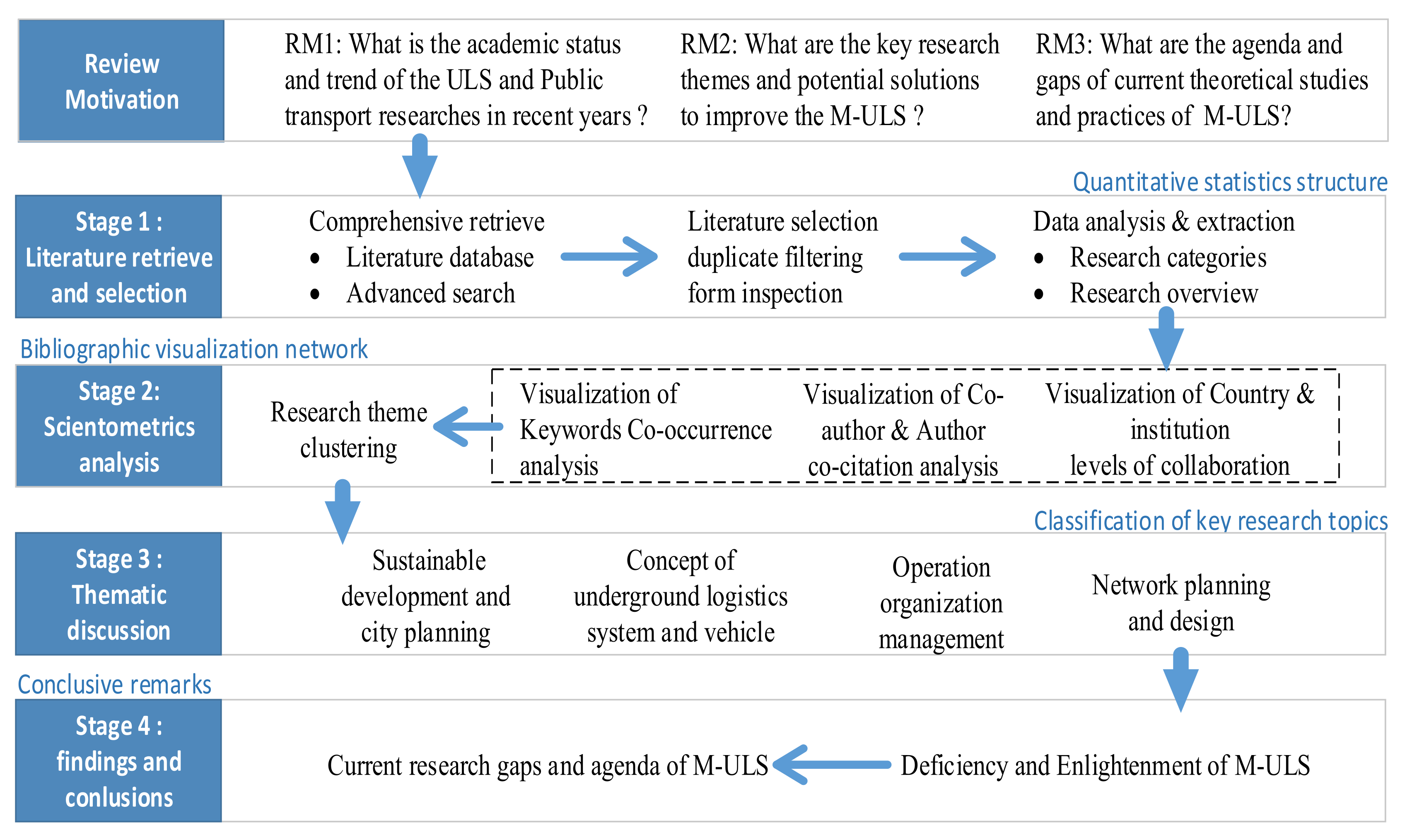
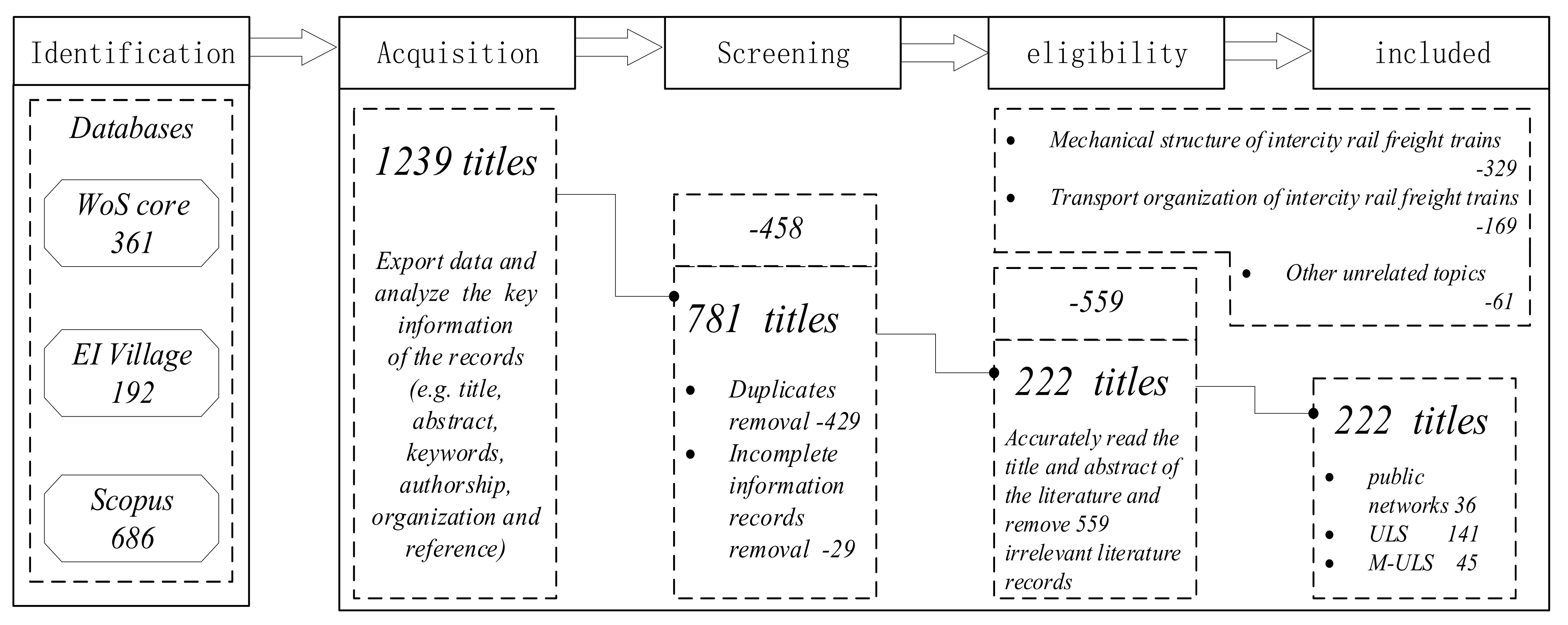
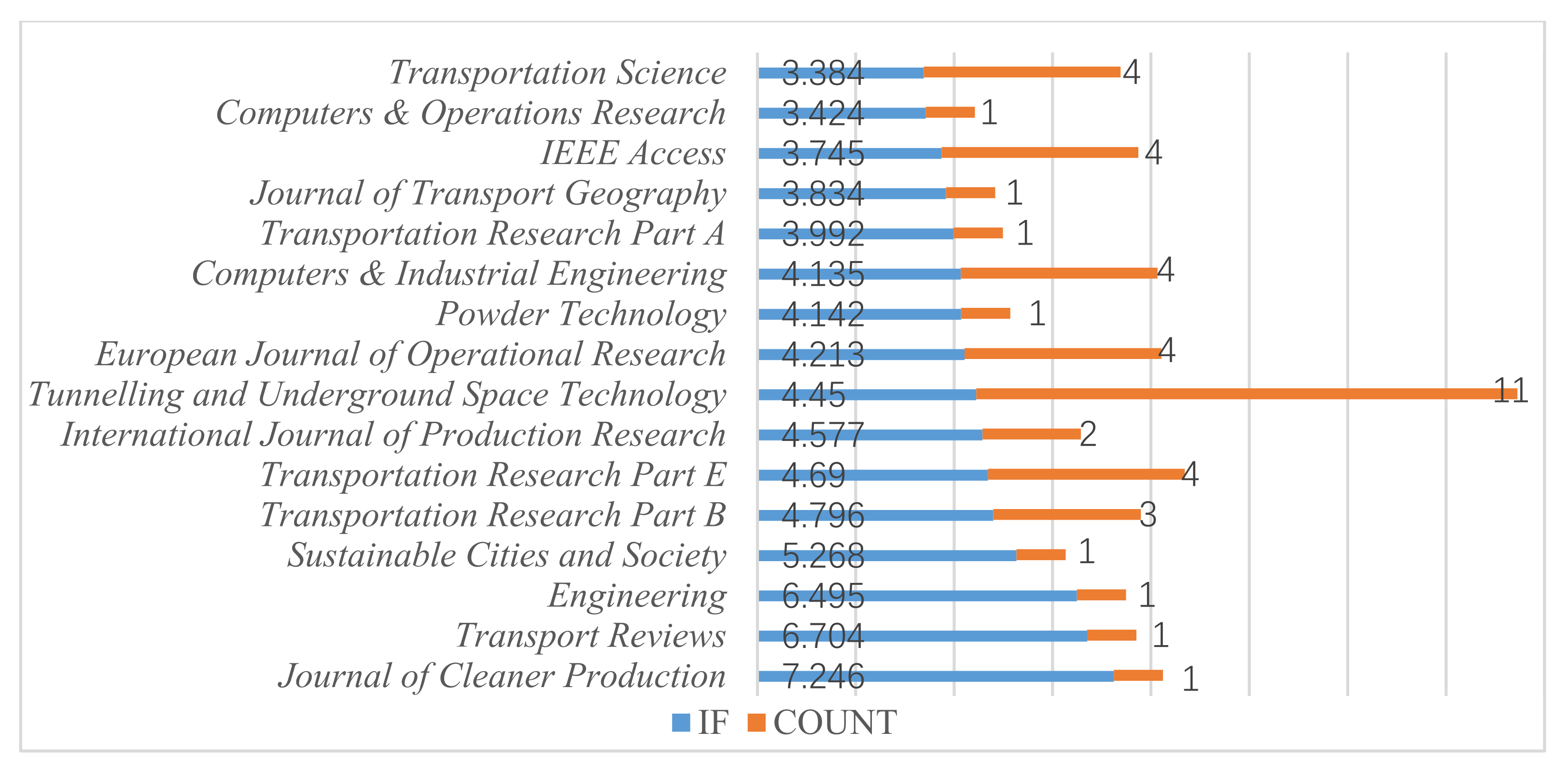
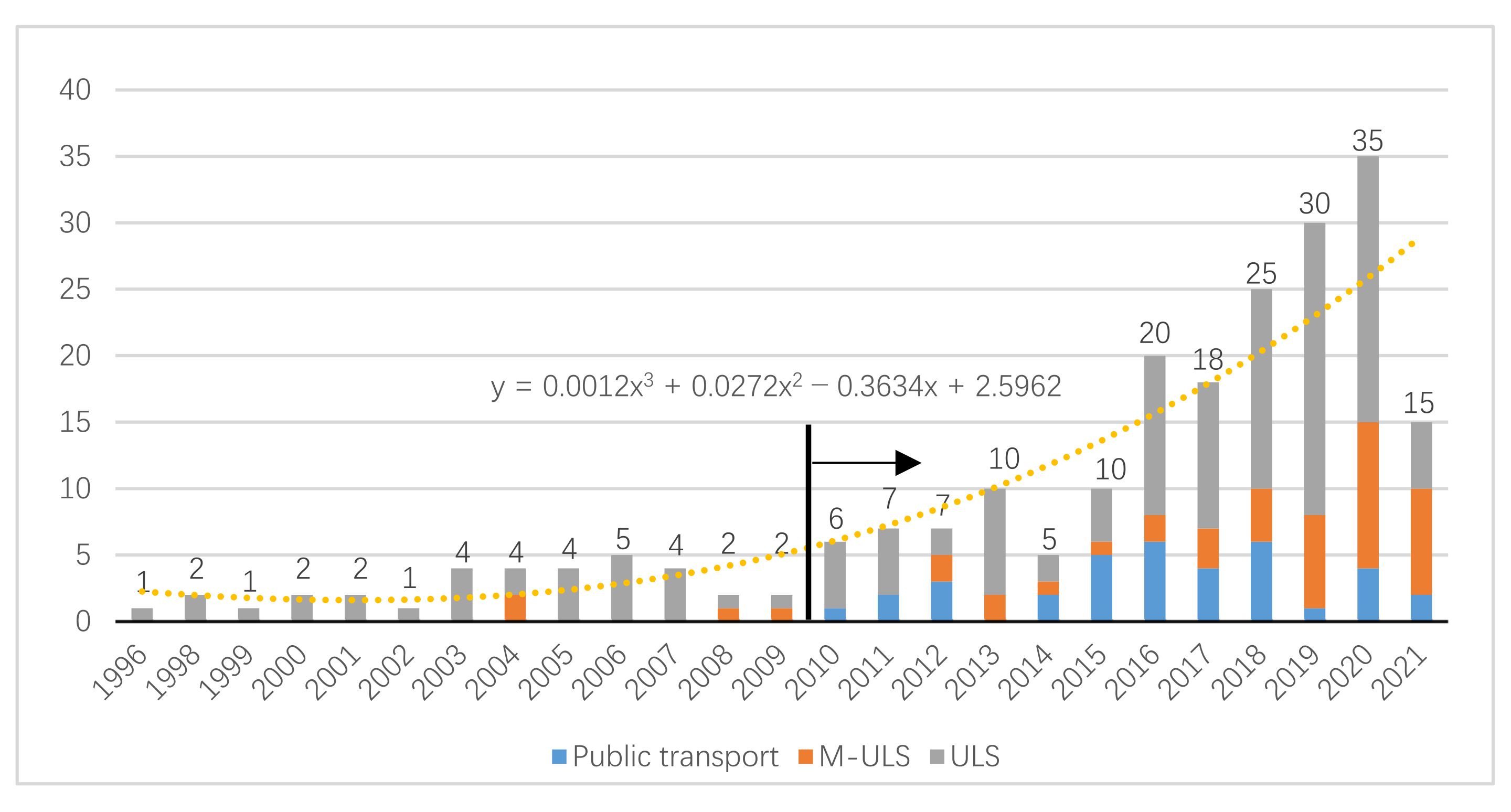
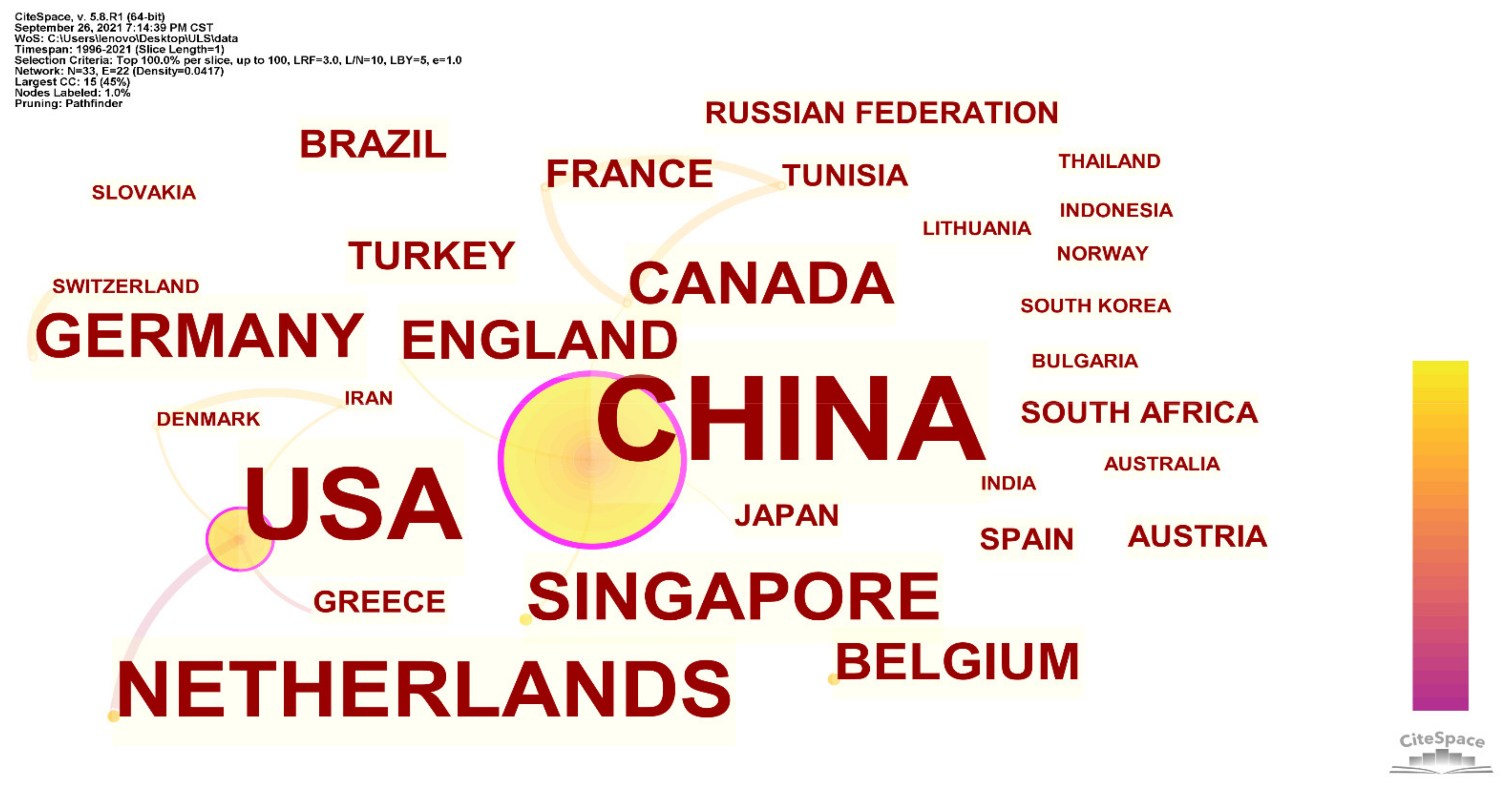


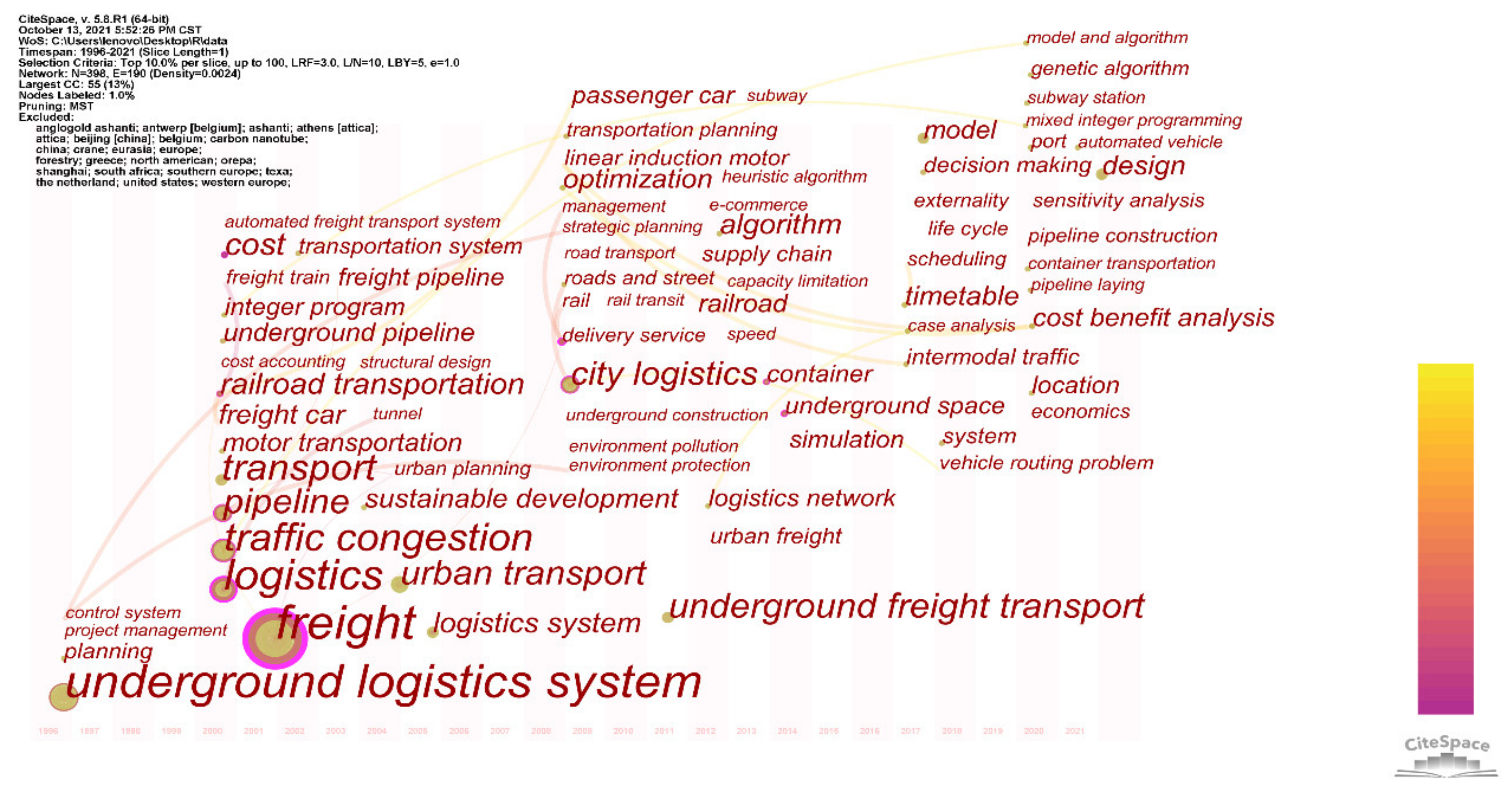
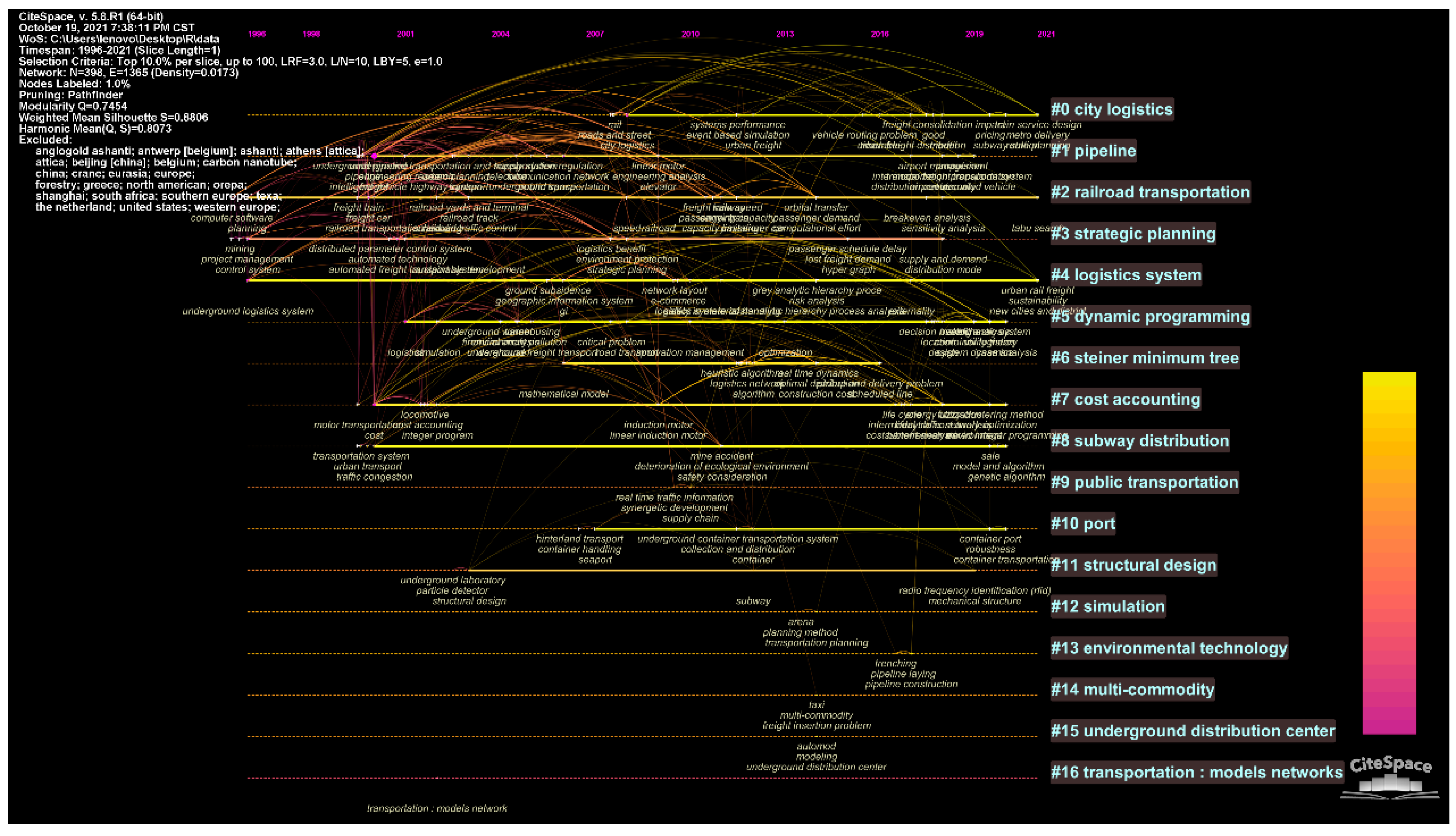
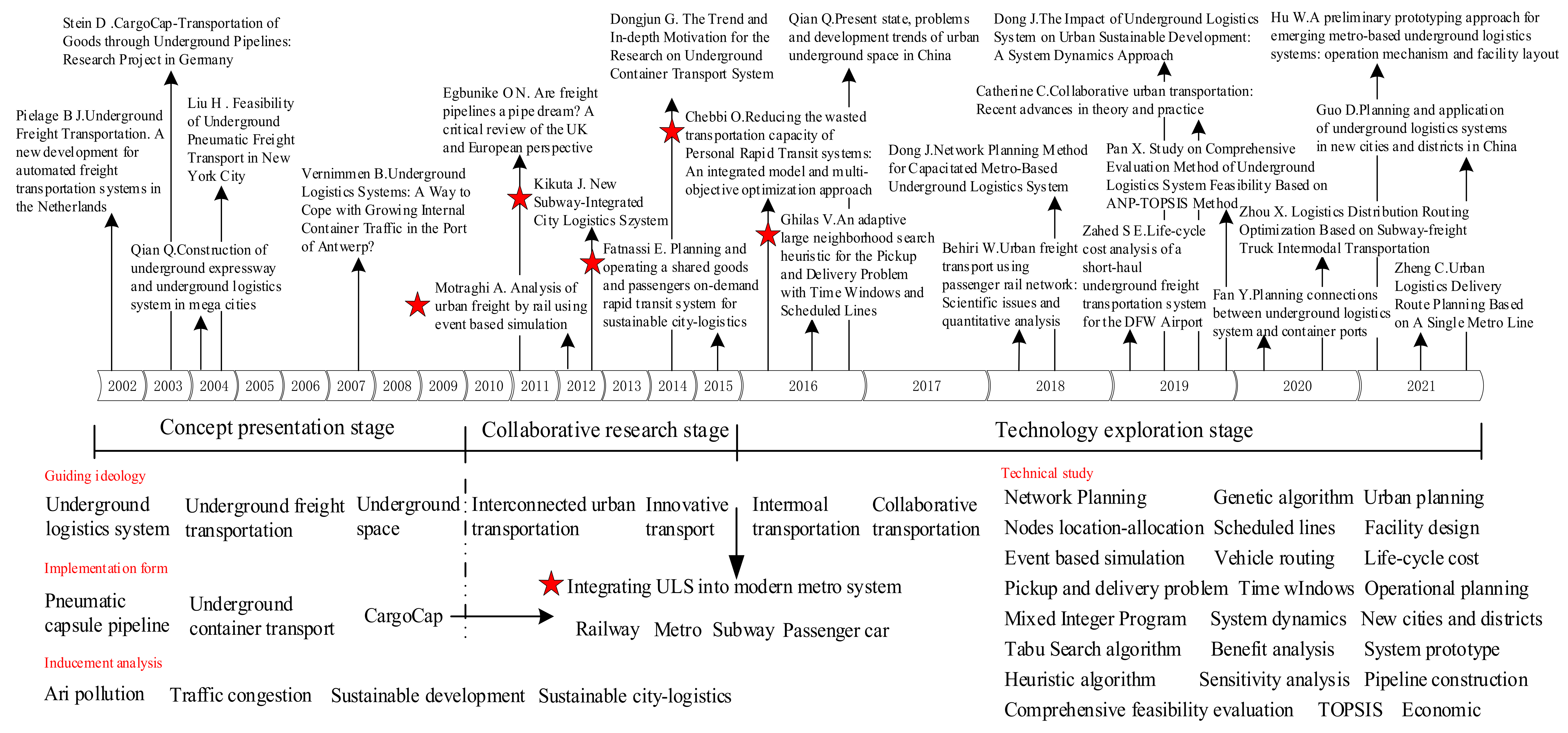
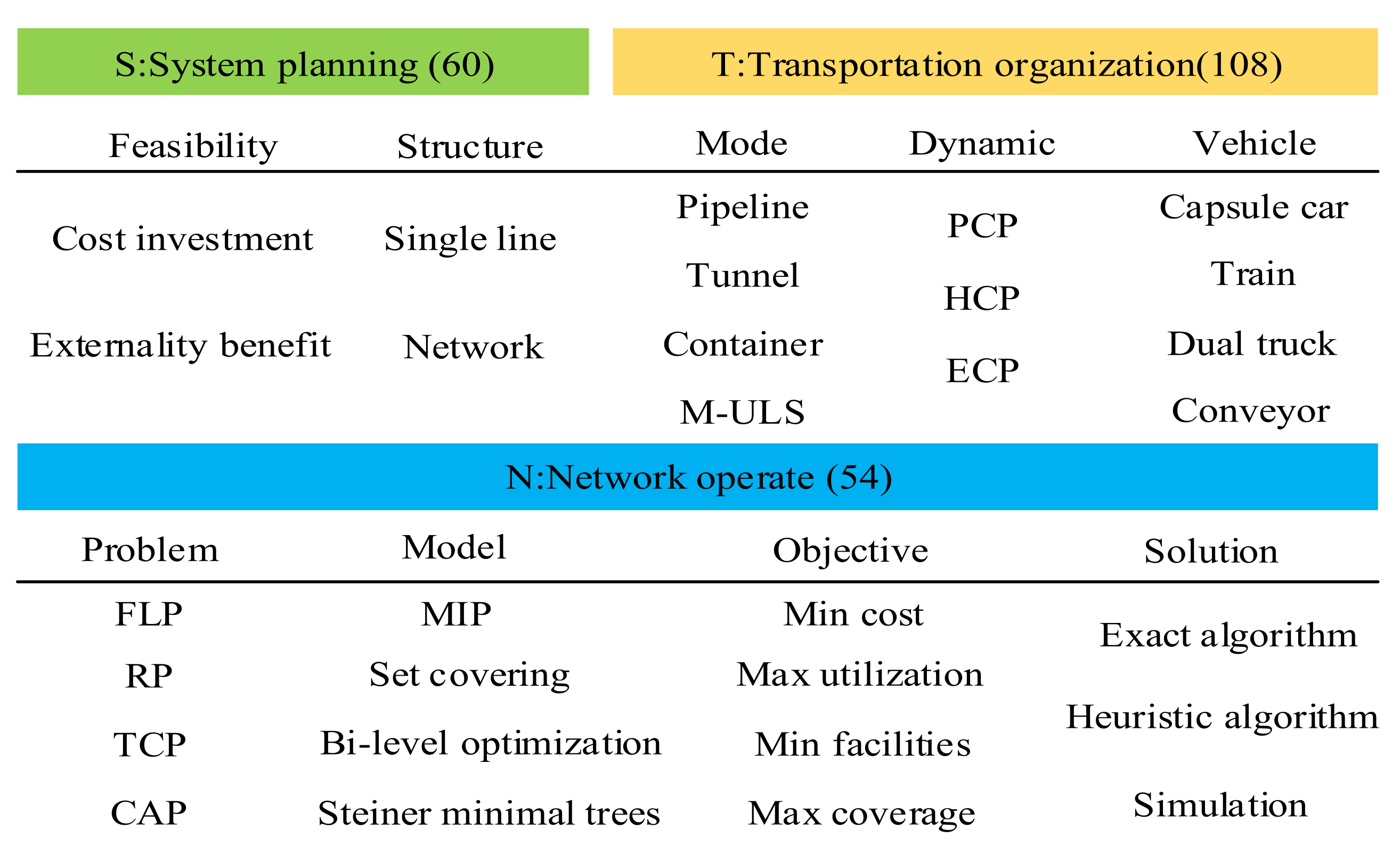
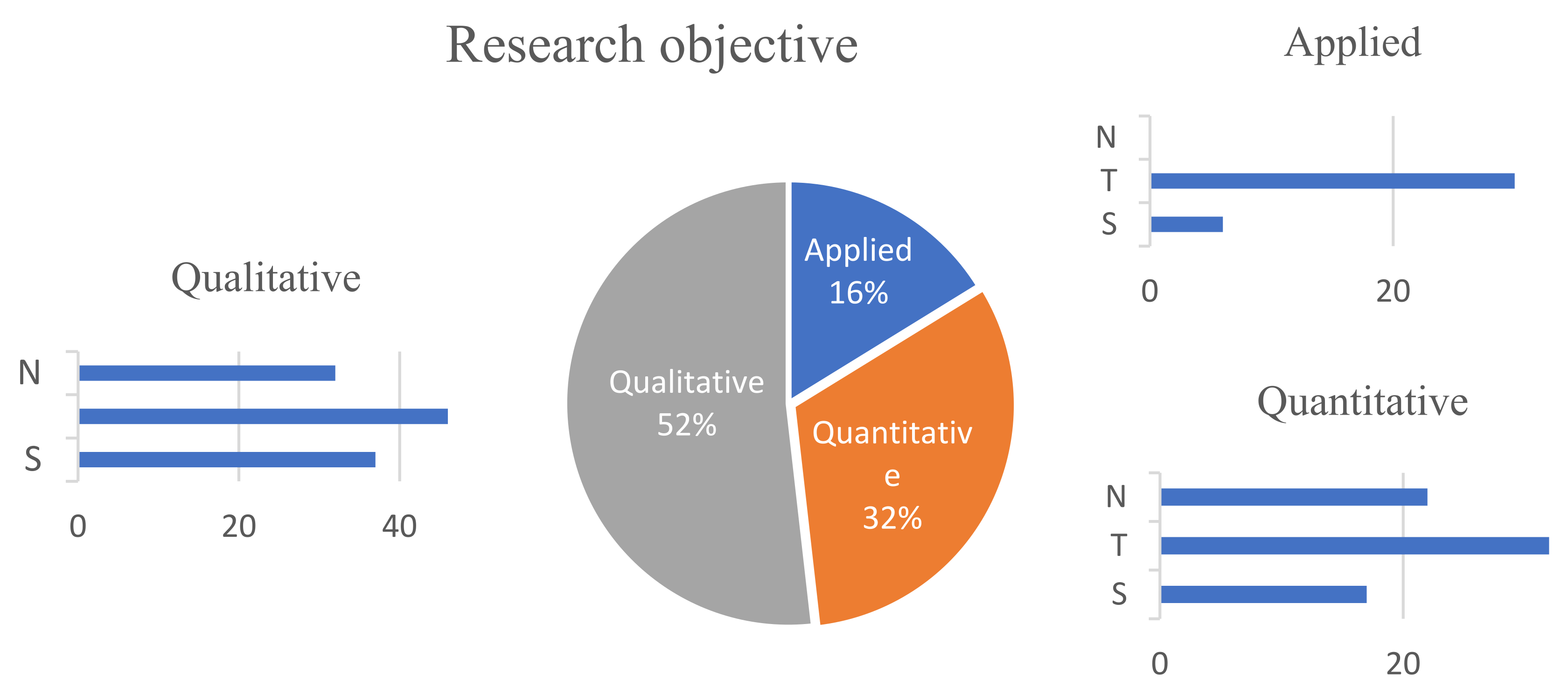
| Mechanical Structure 329 | Transportation Organization 169 | ||
|---|---|---|---|
| Deleted Topics | Count | Deleted Topics | Count |
| Freight train dynamics | 96 | Optimization of freight train operation | 77 |
| Energy saving of freight train | 25 | Freight trains formation and dispatching | 54 |
| Automatic control of freight train | 20 | Train operation safety | 10 |
| Freight train derailment and fault analysis | 36 | Transportation efficiency and cost | 8 |
| Train braking control | 45 | Freight forecast | 5 |
| Train load | 4 | Separation of passenger and freight | 3 |
| Freight train Speed | 11 | Multi−transport | 5 |
| Automatic detection of freight train | 52 | Train delay | 3 |
| Train noise and vibration | 40 | Freight yard operation | 4 |
| Other unrelated topics 61 | |||
| Driver sleep | 2 | Freight train location and recognition | 4 |
| Retraction | 2 | Transportation of dangerous goods | 2 |
| Literature unrelated to freight transport | 23 | Related to freight transport and not easy to classify | 28 |
| Conference | Official Website | Count |
|---|---|---|
| International Society on Underground Freight Transportation (ISUFT) | www.isuft.org (accessed on 1 January 2022) | 15 |
| The American Society of Civil Engineers (ASCE) Pipelines Conference | www.asce.org (accessed on 1 January 2022) | 7 |
| Associated Research Centers for Urban Underground Space (ACUUS) | www.acuus.org (accessed on 1 January 2022) | 5 |
| Parameter | Parameter Setting | Experiment |
|---|---|---|
| Time Slicing | From 1996 JAN To 2021 DEC # Years Per Slice 1 | All Experiments |
| Text Source | Select: Title, Abstract, Author, Keywords (DE), Keywords Plus (ID) | |
| Node Type | Correspondingly select: Country, Author, Cite Author, Keyword | |
| Links | Strength: Cosine # Scope: Within Slices | |
| Selection Criteria | Select top 10% of most cited or occurred items from each slice | 3, 4, 5, 6 |
| Select top 100% of most cited or occurred items from each slice | 1, 2 | |
| Pruning | Pathfinder # Pruning the merged network | 1, 2, 3(a) |
| Minimum Spanning Tree # Pruning the merged network | 3(b), 4, 5, 6 |
| Country | Total of Inst. | Num. of Academic Inst. | Num. of Application Co. | Percentage of Application Co. | Total Freq. |
|---|---|---|---|---|---|
| China | 62 | 53 | 9 | 14.52% | 176 |
| Germany | 12 | 7 | 5 | 41.67% | 16 |
| USA | 9 | 7 | 2 | 22.22% | 33 |
| Singapore | 6 | 5 | 1 | 16.67% | 11 |
| Netherlands | 6 | 4 | 2 | 33.33% | 23 |
| Canada | 5 | 5 | 0 | 0.00% | 7 |
| UK | 4 | 4 | 0 | 0.00% | 9 |
| Belgium | 1 | 1 | 0 | 0.00% | 5 |
| NO. | Scholar | Institution | Count | Country |
|---|---|---|---|---|
| 1 | Qihu Qian | Army Engineering University of PLA | 19 | China |
| Zhilong Cheng | 19 | China | ||
| DongJun Guo | 8 | China | ||
| 2 | Zhilong Cheng | Army Engineering University of PLA | 19 | China |
| JianJun Dong | Nanjing Tech University | 15 | China | |
| Rui Ren | 13 | China | ||
| B HWANG | National University of Singapore | 8 | China | |
| WanJie Hu | Nanjing Tech University/Beijing Tech University | 8 | China | |
| 3 | S Mohsen | University of Texas at Austin | 16 | USA |
| M NAJAFI | 15 | USA | ||
| Sirwan Shahooei | 7 | USA | ||
| Siamak Ardekani | 7 | USA |
| Scholar | Institution | Count | Country |
|---|---|---|---|
| Visser Jgsn | Delft University of Technology | 35 | Netherlands |
| Liu Henry | Freight Pipeline Company | 34 | USA |
| QiHu Qian | Chinese Academy of Engineering Army Engineering University of PLA | 31 | China |
| Egbunike ON | Cardiff University | 26 | UK |
| Najafi Mohammad | University of Texas at Austin | 26 | USA |
| JianJun Dong | Nanjing Tech University | 23 | China |
| Stein Dietrich | WG Pipeline Construction Maintenance Ruhr-University Bochum, Bochum | 23 | Germany |
| Jun Kikuta | Docon, Atsubetsu-ku, Sapporo | 21 | Japan |
| ZhiLong Chen | Army Engineering University of PLA | 20 | China |
| Eiichi Taniguchi | Kyoto University | 17 | Japan |
| Topic Group | Cluster ID | Size | Silhouette | Mean Year | Cluster Label (LLR) |
|---|---|---|---|---|---|
| G1: Urban underground logistics system and planing | 0 | 15 | 0.889 | 2014 | city logistics |
| 11 | 4 | 0.945 | 2006 | structural design | |
| 13 | 3 | 0.969 | 2017 | environmental technology | |
| 15 | 1 | 1 | 2014 | underground distribution center | |
| 4 | 10 | 0.983 | 2010 | logistics system | |
| G2: Design and implementation of transportation organization research | 1 | 19 | 0.793 | 2008 | pipeline |
| 2 | 18 | 0.919 | 2009 | railroad transportation | |
| 8 | 8 | 0.98 | 2009 | subway distribution | |
| 9 | 2 | 0.985 | 2010 | public transportation | |
| 10 | 6 | 0.986 | 2014 | port | |
| 14 | 1 | 1 | 2014 | multi-commodity | |
| G3: Network structure and operation optimization | 3 | 11 | 0.909 | 2004 | strategic planning |
| 5 | 18 | 0.745 | 2013 | dynamic programming | |
| 6 | 8 | 0.979 | 2012 | Steiner minimum tree | |
| 7 | 14 | 0.838 | 2009 | cost accounting | |
| 12 | 2 | 1 | 2014 | simulation | |
| 16 | 1 | 0.936 | 2002 | transportation: models networks |
| Terms | Strength | Duration | Terms | Strength | Duration |
|---|---|---|---|---|---|
| underground freight transport | 4.9821 | 2016–2019 | propulsion system | 2.4866 | 2019–2019 |
| underground logistics system | 4.309 | 2019–2021 | capacity limitation | 2.3815 | 2020–2021 |
| freight trains | 3.5602 | 2015–2015 | intermodal terminals | 2.3712 | 2018–2019 |
| passenger trains | 3.4485 | 2014–2015 | real-world simulation | 2.3404 | 2019–2021 |
| freight | 3.0426 | 2015–2017 | mathematical model | 2.2197 | 2013–2016 |
| city logistics | 2.9897 | 2020–2021 | urban freight distribution | 2.1804 | 2017–2018 |
| civil engineers | 2.9638 | 2018–2019 | sensitivity analysis | 1.9836 | 2020–2021 |
| auto freight transport system | 2.7677 | 2018–2019 | new mode | 1.9494 | 2019–2021 |
| carrying freight | 2.5933 | 2016–2017 | underground space | 1.9456 | 2016–2016 |
| underground pipelines | 2.5484 | 2016–2017 | engineering geology | 1.9256 | 2013–2013 |
| System | Nation | Power | Cargo unit | Vehicle | Speed (km/h) | References |
|---|---|---|---|---|---|---|
| DMT | Japan | Hybrid vehicle | — | Truck | City:45 Intercity:100 | [59] |
| FSS | USA | Electric | 45ft Container | Locomotive | 105 | [60] |
| MUFP | UK | Electric | Tray 1 × 1.2 × 1.8 | Bulk | 21 | [61] |
| CargoCap | Germany | Electric Maglev | European tray 0.8 × 1.2 × 1.05 | Capsule car | 36 | [62] |
| Hyperloop | USA | Electric Maglev | Container, Pallet | Large cabin | 1126 | [63] |
| CST | Switzerland | Electric | Small package | Suspended conveyor | 60 | [64] |
| Tray | AGV | 30 | ||||
| OLS-ASH | Netherlands | Electric | Tray | AGV | 20–40 | [65] |
| References | Problem | Mode | Model | Solution | Background | Factor | Objective | Network Classification |
|---|---|---|---|---|---|---|---|---|
| [87] | FLP | ULS | Set covering model. 0–1 MIP | Bat-inspired algorithm | Shanghai, China | Demand, construction and fixed and distribution costs | Minimize number of logistics nodes and associated costs | Logistics center Distribution center. |
| [36] | FLP | MULS | Complex network P-median model | TOPSIS, AHP | Shanghai, China | Node importance index, demand, distance | Minimize distance between the demand and the metro freight hub | Metro freight hub |
| [88] | FLP | MULS | P-median model | Voronoi diagram, Shortest pathalgorithm | Nanjing, China | Infrastructure cost, distance, capacity limit, passenger impact cost, logistics cost | Minimize the transport costs | One Level |
| [89] | FLP | ULS | Set covering and Weighted set covering model | Iterative evolution | — | Congestion index, weighted distance, freight volume | Minimize the number of facilities | Tow Level |
| [90] | FLP | ULS | ISM | — | — | Geology, freight flow, traffic impedance, service level, cost and other 27 factors | Analyze the relationship between influencing factors | — |
| [91] | FLP | ULS | Bi-level optimization model | Heuristic algorithm | — | Operating and fixed and transport cost, demand, capacity limit | Upper level: minimize logistics cost Lower level: minimize the cost per customer | One Level |
| [86] | FLP | UELS | Multi-objective model | Iterative evolution | Shanghai, China | Congestion index, rescue distance, rescue time, special nodes, covered areas | Minimize rescue time and station construction cost | One Level |
| [92] | RP | ULS | Steiner minimal trees model | PGSA | — | — | Algorithm comparison | One Level |
| [93] | RP | ULS | MIP | SA | — | Cost, capacity limit, congestion index | Minimize cost | Tow Level |
| [28] | RP | ULS | Evaluating Model Dynamic programming | Uncertainty graph Improved SA | Nanjing, China | Cost, uncertainty index | Minimize total path length | One Level |
| [94] | LRP | ULS | Bi-objective linear MIP Linear MIP | GA-MPSO Floyd–Warshall | Beijing, China | Path construction and transport and node activated cost, capacity limit, path utilization | Minimize costs Maximize system utilization | Distribution centers Ground terminal |
| [95] | LRP | ULS | MIP | GA-FCM, DFS-FCM; DA | Nanjing, China | Minimize costs | ||
| [37] | LAP | MULS | Evaluating model MIP | E-TOPSIS, Heuristic algorithm | Nanjing, China | Service capacity, freight flow, regional accessibility, distance | Minimize number of facilities Minimize costs | Metro freight hub Ground terminal |
| [96] | LARP | MULS | Fuzzy stochastic programming MIP | Binary chaotic GA Exact algorithm | — | Demand, cost, capacity limit, | Minimize construction and operation cost Maximize system utilization | |
| [97] | LARP | MULS | Entropy TOPSIS model MIP | Exact algorithm Immune clonal selection algorithm Floyd–Warshall | Nanjing, China | Single freight flow, order priority, capacity limit, cost regional accessibility | Minimize set coverage Minimize construction and operation cost | Metro freight hub Ground terminal |
| [98] | LRP | ULS | Multi-objective model. | GA | China | Capacity limits, price, node construction and pipeline construction and transport and transfer cost. | Minimize cost | Disposal center Transfer station |
| [29] | LRP | ULS | Set covering modelMIP | Fuzzy clustering | Nanjing, China | Capacity limit, congestion and construction and transport cost | Minimize number of facilities Minimize cost | Tow Level |
| [99] | LRP | MULS | E-TOPSIS Max-covering model | Greedy randomized adaptive search TS | Shanghai, China | Capacity limit, distance | Maximize coverage Minimize distribution distance | Tow Level |
| [100] | FLPTCP | MULS | MIP, Multi-assignment P-hub median and P-hub covering problem | Modified GA | Shanghai, China | Demand, capacity limit, construction and operating costs | Minimize cost | Ground terminal |
| [39] | TCP | MULS | MIP | Modified GA | — | Metro surplus capacity, truck capacity, maximum driving distance, customer service time window | Minimize distribution distance | One Level |
| [101] | TCP | UCTS | Nonlinear MIP | Simulation | Shanghai, China | Waiting and arrival time, capacity limit, lifting cost | Minimize total cost of the crane and waiting cost of vehicle queuing | One Level |
| [102] | TCP | UCTS | 0–1 planning model | Simulation | Shanghai, China | Investment and operating cost, time | Minimize cost | One Level |
| [45] | FLPTCP | UCTS | Robust optimization model | Simulation | Shanghai, China | Capacity limit, construction and transportation and management cost, uncertain container volume | Minimize cost | One Level |
| [103] | CAP | ULS | Nonlinear MIP Baumol–Wolfe model | Approximate iterative algorithm | — | Transport and loss cost, pipeline capacity, node service capacity | Minimize cost | Underground hub Ground terminal |
| [104] | CAP | ULS | Utility theory method Stochastic assignment model | K-shortest path routing algorithm | — | Travel speed, capacity limit of lines and nodes, departure frequency | Minimize generalized cost | One Level |
Publisher’s Note: MDPI stays neutral with regard to jurisdictional claims in published maps and institutional affiliations. |
© 2022 by the authors. Licensee MDPI, Basel, Switzerland. This article is an open access article distributed under the terms and conditions of the Creative Commons Attribution (CC BY) license (https://creativecommons.org/licenses/by/4.0/).
Share and Cite
Zhang, H.; Lv, Y.; Guo, J. New Development Direction of Underground Logistics from the Perspective of Public Transport: A Systematic Review Based on Scientometrics. Sustainability 2022, 14, 3179. https://doi.org/10.3390/su14063179
Zhang H, Lv Y, Guo J. New Development Direction of Underground Logistics from the Perspective of Public Transport: A Systematic Review Based on Scientometrics. Sustainability. 2022; 14(6):3179. https://doi.org/10.3390/su14063179
Chicago/Turabian StyleZhang, Han, Yongbo Lv, and Jianwei Guo. 2022. "New Development Direction of Underground Logistics from the Perspective of Public Transport: A Systematic Review Based on Scientometrics" Sustainability 14, no. 6: 3179. https://doi.org/10.3390/su14063179
APA StyleZhang, H., Lv, Y., & Guo, J. (2022). New Development Direction of Underground Logistics from the Perspective of Public Transport: A Systematic Review Based on Scientometrics. Sustainability, 14(6), 3179. https://doi.org/10.3390/su14063179






